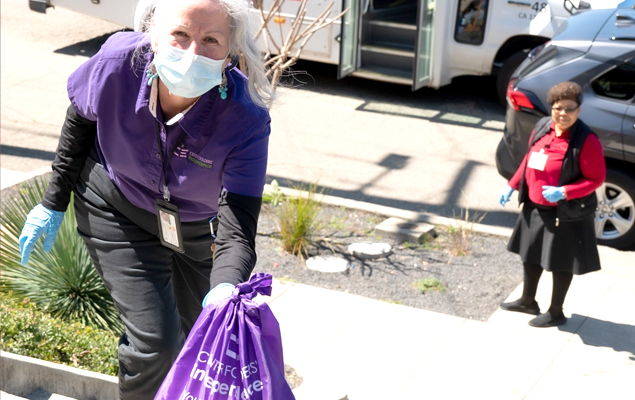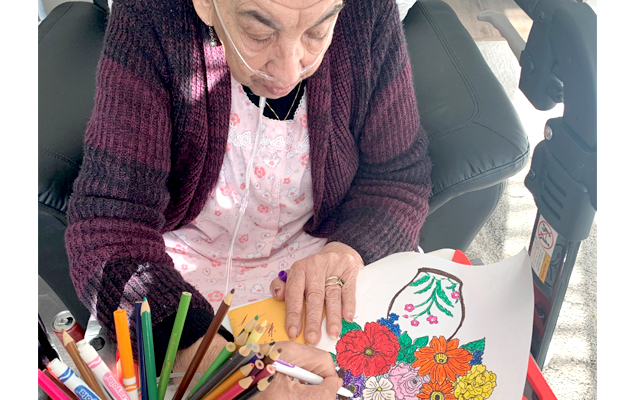
Pandemic response limits isolation for seniors
Social isolation has proven to be one of the most unfortunate realities of the COVID-19 pandemic, especially for seniors who live with serious medical conditions—one of the populations most vulnerable to COVID-19.
For many years prior to the pandemic, some Bay Area organizations that serve the elderly have been delivering programs focused on social interaction. The pandemic has forced a radical shift in their services to keep vulnerable seniors safe, healthy and connected.
On Lok is a Bay Area nonprofit organization that operates the Program of All-inclusive Care for the Elderly (PACE), which allows seniors to live at home for as long as possible by providing comprehensive medical care and social services.
Daniel Guzman-Garza has been working for On Lok for 24 years and is currently a Center Supervisor at the San Francisco location.
“Because of the pandemic we had to close all of our centers and change the way we serve and help our participants,” says Guzman-Garza. “We have expanded our services to the community so there is no need for our participants to come to the centers -- a staff member will go to the home of the participant and bring food, prescriptions, supplies, etc.”
On Lok centers began offering tele-health to seniors at home. With the supervision of nurses, dietitians, and caretakers, they identified the level of needs for each participant to customize the help they receive.
“The change has been drastic,” says Guzman-Garza. “The participants are missing the socialization with the other members and people but also they are afraid. There are families that prefer not to have visitors and they request just phone calls to check that everything is okay with the participant”.
Regarding technology, Guzman-Garza says it has been a great effort for program participants to get familiar and comfortable with the new way of interaction and communication, but it hasn’t been a barrier to serve and help participants. On Lok has a YouTube channel to offer participants appropriate entertainment, like reading a book, playing an instrument and different activities.
“Also, we have volunteers who talk to our participants so they do not feel isolated,” adds Guzman-Garza. “Also, we send packages with coloring books, puzzles and different activities so participants are not watching only the TV news.”
Another organization with a long history of serving the elderly in the Bay Area is the Center for Elders’ Independence (CEI). CEI helps at-risk seniors live at home, rather than in nursing homes, through a national program of integrated care known as PACE (the Program of All-inclusive Care for the Elderly). PACE provides full medical, dental, vision, podiatry, home care and case management services reimbursed by both Medicare and Medi-Cal. CEI serves seniors in Alameda and Contra Costa counties with PACE centers in Oakland, Berkeley, and San Leandro.

To continue providing care as an essential service during the pandemic, CEI had to quickly recreate itself and find new ways to operate. CEI’s Chief Executive Officer Linda Trowbridge calls it a “stunning” transformation.
“Within a week, we had to decompress taking care of 900 people a day at our five centers to being able to serve everyone in their homes,” says Trowbridge.
CEI’s centers have remained open to a limited number of participants who need in-person medical attention and those who do not have a safe place to shelter-in-place during the day.
“We redesigned all of our care systems to ensure the safety of staff and participants,” said Dr. James Mittelberger, CEI’s Chief Medical Officer. “Technology accelerates our ability to deliver quality care where it makes the most sense for every person we serve.”
CEI clinical staff bring iPads to seniors’ homes for “virtual doctor visits,” that include listening to heart and lungs remotely, which is a key health status check during the pandemic. Language interpreters assist as needed, via Zoom online or by phone during telehealth visits.
CEI’s integrated care team of doctors, nurses, nutritionists, social workers, activity managers, and therapists, is now doing most assessments using Zoom. Everyone meets together virtually at home with the participant for evaluations that shape each senior’s all-inclusive personalized care plan.
The focus of CEI’s activity program is to reduce isolation, which can be a major obstacle to maintaining homebound seniors’ health and resilience. At the start of the pandemic, only 10 percent of CEI participants had online capability. It’s been a challenge to boost digital literacy and quickly get as many seniors online as possible to join virtual activities and socialize with each other. For CEI’s activity staff, it’s been a slow process to set up seniors case-by-case to use smartphones and iPads. Patience and persistence are paying off.
“It’s all worth it when you get people on the screen, when they can see and talk to each other, their eyes light up,” said Andrew Hayes, Activity and Volunteer Manager. “Participants literally broke down in tears because they got to talk to their tablemates that they hadn’t spoken to in weeks.”
CEI offers twenty scheduled online video activities every week, from exercise to trivia games, karaoke, history discussions, cooking classes, arts and crafts, live music, spiritual counseling, and virtual bingo.